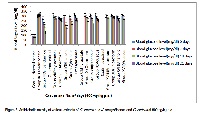Anti-diabetic potentials of Clerodendrum inerme, Jasminum mesyni Hance and Callistemon citrinus on nicotinamide-streptozotocin induced type 2 diabetic rats
Keywords:
Antidiabetic activity, leaf extracts, wistar rats, Nicotinamide, StereptozotocinAbstract
To investigate antidiabetic potential of alcoholic leaves extract of Clerodendrum inerme, Jasminum mesyni Hance and Callistemon citrinus on nicotinamide-streptozotocin induced type 2 diabetic rats The comparative antidiabetic activity was conducted in NAD+STZ wistar rats of either sex. The leaves extracts of C. inerme, J. mesyni Hance and C. citrinus were administered at a dose of 400 and 600mg/kg p.o. for 4 Weeks and observed for antidiabetic study. During 28 days of treatment, rats were observed weekly for hypoglycaemic activity. The glucose level of all groups were determined after 0, 7, 14, 21 days. The blood samples for glucose estimation were withdrawn by retro-orbital plexus puncture method for antidiabetic activity. All the plant extracts lowered the blood glucose level after 21 days significantly with respect to the diabetic control. However, only ethanolic extract of C. inerme at 400mg/kg p.o. exhibited maximum reduction of blood glucose level as compared to the J. mesyni Hance and C. citrinus. The results demonstrated that C. inerme has potent antidiabetic effect as compared to extracts of another two plants.
References
. Nagarajan S. Cultivation and Utilization of Medicinal Plants. Jammu-Tawi: CSIR; 1982. p. 584-604.
. Calis I, Hasny M, Yuruker A. Inerminosides A1, C and D, three iridoid glycosides from Clerodendrum inerme. J. Phytochem. 1994;37(4):1083-1085.
. Pandey R, Verma RK, Gupta MM. Neo-clerodane diterpenoids from Clerodendrum inerme. Phytochem. 2005;66(6):643-648.
. Kanchanapoom T, Kasai R, Chumsri P, Hiraga Y, Yamasaki K. Mega stigmane and irioid glucosides from Clerodendrum inerme. J. Phytochem. 2001;58:333-336.
. Rastogi RP. Compedium of Indian Medicinal Plants. New Delhi: CDRI and NISCAIR; 2007. p. 368.
. Kuwajima H, Matsuuchi K, Inoue K, Fujita T, Inouye H. Secoiridoid glucosides from Jasminum mesyni hance. Phytochem. 1985;24(6):1299-1303.
. Matsuda S, Inouye H, Zasshi Y. Two secoiridoid glycosides from Jasminum mesyni hance. Phytochem. 1984;21(4):1232.
. Oyedeji OO, Lawal OA, Shode FO, Oyedeji AO. Chemical composition and antibacterial activity of the essential oils of Callistemon citrinus and Cllistemon viminalis from South Africa. Molecules.2009;14:1990-1998.
. Harborne JB. Phytochemical Method: A Guide to Modern Techniques of Plant Analysis. 2nd ed. New York: Chapman and Hall; 2005. p. 40-56.
. Mukherjee K. Quality Control of Herbal Drugs. 1st ed. New Delhi: Business Horizons; 2002. p. 9,15,559.
. Chatterjee A. The Treatise on Indian Medicinal Plants. New Delhi: Publications and Information Directorate; 1997. p. 17-18.
. Parsad SK, Kulshreshtha A, Qureshi TN. Antidiabetic activity of some herbal plants in streptozotocin induced diabetic albino rats. Pakistan J Nutr. 2009;(5):551-557.
. Pullaiah T. Antidiabetic Plants in India and Herbal based Antidiabetic Research. India: Regeny Publications; 2003. P. 144,209.
. Deshpade J. A Handbook of Medicinal Herbs. India: Agrobios; 2006. p. 117-118.
. Ghosh MN. Fundamentals of Experimental Pharmacology. 4th ed. Kolkata: Hilton and Company; 2008. p. 176-183.
. Bonge KP, Penlap BV, Mbofung, CM. Acute and sub-acute toxicity of the methanol extract from Holarrhena floribunda. Eur J Exp Biol. 2012; 2(4):1284-1288.
. Burger C, Fischer DR, Filo VC. Acute and subacute toxicity of the hydroalcoholic extract from Wedelia paludosa in mice. J Pharm Sci. 2005;8(2):370-373.
. Devbhuti D, Gupta JK, Devbhuti P, Bose H. Phytochemical and acute toxicity study on Bryophyllum calycinum. Acta Pol Pharm. 2008;65(4):501-504.
. Bhardwaj S, Gupta D. Study of acute, subacute and chronic toxicity test. Int J Adv Pharm Biol Sci. 2012;(2):103-129.
. Biswas NR, Sen S, Singh S, Gopal N, Pandey RM, Giri D. Sub-acute toxicity study of a polyherbal drug in rats. Indian J Pharmacol. 1998;30(1):239-244.
. Hilaly J, Hilaly JE, Isrili ZH & Badiaa L. Acute and chronic toxicological studies of Ajugaiva in experimental animals. J Ethnopharmacol. 2004;91:43-50.
. Hussain T, Farred S, Siddiqui H, Vijay kumar M, Venkateswara R. Acute and sub-acute oral toxicity evaluation of Tephrosia purpurea extract in rodents. Asian Pac J Trop Dis. 2012;8:129-132.
. Joshi CS, Priya ES & Venkatraman S. Acute and subacute toxicity studies on the polyherbal antidiabetic formulation Diakyur in experimental animal models. J Health Sci. 2007;53(2):245-249.
. Senthil MK, Shiva KP, Perumal P. Evaluation of anti-diabetic activity of Bambusa vulgaris leaves in streptozotocin induced diabetic rats. Int. J. Pharm Sci. Res. 2011;3(3):208-210.



